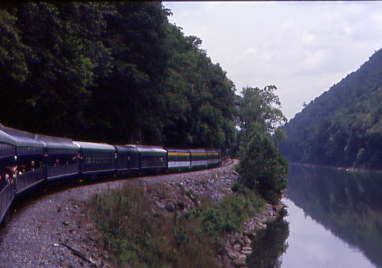
Following an excellent continental breakfast at the South Branch Inn, Chris Parker and I checked out and drove to the Potomac Eagle Scenic Railroad parking lot just north of Romney, West Virginia. Here I bought our tickets then walked back across the tracks to the highway to obtain the train's consist.
Potomac Eagle Scenic Railroad OverviewIt was a state Public Service Commission study that first suggested that a scenic excursion train would be successful on the South Branch Valley Railroad. From that study members of the Romney Business and Professional Organization began their effort to make the idea a reality. A few years lapsed before the Potomac Eagle became the company in charge of making the dream of a few a source of pleasure for many. And by coincidence that time frame was also when a few American bald eagles decided to make the Trough, a narrow passage the train tracks and the river share, a permanent home. In the fall of 1991, the Eagle Canon Passenger Car Company began operating the Potomac Eagle from a siding named Wappocomo Station just north of Romney.
And that’s before passengers get to the 6-mile Trough, where eagles almost always await train visitors. Sometimes passengers see one eagle, and then other trips provide visitors with the chance to see several. It is not a guarantee to see America's greatest symbol on the Potomac Eagle, but it’s a pretty good bet that passengers will see at least one. It’s almost as if they come out on cue to perform in all their spectacular style.
Potomac Eagle Scenic Railroad HistoryMost visitors on the Potomac Eagle are unaware of the long but storied past of the South Branch Valley Railroad. The line has been a vital part of the valley from Green Spring to Petersburg for well over 100 years. The South Branch Valley Railroad comprises a 52.4-mile route from Petersburg to Green Spring where it links to the CSXT mainline connecting Cumberland, MD to Martinsburg, WV. The SBVR generally parallels the South Branch of the Potomac River – from which the railroad takes its name. Crossing Hampshire, Hardy and Grant counties, the SBVR serves the towns of Romney, Moorefield and Petersburg. The railroad is headquartered in Moorefield. It is owned and operated by the West Virginia State Rail Authority. State employees perform maintenance and freight operations.
But at least one early effort to build the line was futile. In 1875 a group of residents of Kanawha County, West Virginia formed a company designated the West Virginia Railroad Company. The group obtained authority to cross the state with a railroad which would commence on the Kentucky state boundary line and pass through Cabell, Wayne, Putnam, Kanawha, Braxton, Clay, Webster, Upshur, Randolph, Pendleton, Hardy and Hampshire counties. The line was supposed to extend to a point near the South Branch River near the Maryland state boundary line. The charter, which is on record in the Hardy County Clerk’s Office, discloses that the proposed railroad was to follow in a general course, the South Branch River through Pendleton, Grant, Hardy and Hampshire counties.
While those pioneers had the best of intentions and dreams, the smoke from a locomotive in Hardy County was still not to be seen for many years. In February 1880, a company called the Cumberland, Moorefield and Petersburg Railroad was organized to build a line between Green Spring and Petersburg. Little is known of the company other than they did not get their line built. However, on Sept. 1, 1884, a new company called the South Branch Railroad completed the line from Green Spring to Romney.
It was not until after the turn of the century that a rail line was built south of Romney. In 1909 construction started for a new company known as The Hampshire Southern RR. The company was headed by William B. Cornwell, brother of soon to be Governor John J. Cornwell. In 1910 the first trains providing freight and passenger service between Romney and Moorefield were operated on the new railroad.
This system was sold to the Moorefield and Virginia Railroad Company in 1911 with the purchaser assuming a mortgage existing against the line in the amount of $700,000. William Cornwell and Eugene Ailes, son-in-law of Governor Cornwell, were officers of the grantor company. In November 1913 the Moorefield and Virginia Company transferred the system to the Baltimore and Ohio Railroad Company. Passenger service was abandoned on the line sometime around 1928.
In the mid-1970's, the line was abandoned by the B&O. It was taken over by the State of West Virginia on October 11, 1978, as government officials became concerned over the harm that would come to existing industry and the prospects of driving away new business along the line. Track rehabilitation began on the 52-mile stretch, but the famous flood of 1985 knocked out four bridges and left 13 miles of track with heavy damage and 23 miles with moderate damage. It was reported that in some stretches in the Trough that rail and ties hung in mid-air with all traces of road bed gone beneath them.
Freight service operates five days a week, Monday through Friday, with special and unit train operations on weekends as needed. The SBVR’s largest customer is Pilgrim’s Pride in Moorefield. Pilgrim’s feed mill receives corn and other commodities used in the manufacture of its poultry feed. Nearly all of the corn arrives in 65-car unit trains which must be moved to the feed mill, unloaded and returned to CSXT in less than 48 hours. Three customers are located in Petersburg: Adell Polymers ships and receives loads of plastic pellets, Allegheny Wood Products ships finished lumber and Greer Lime ships outbound loads of lime. In 2004, the SBVR handled 4,243 revenue loads.
During its first ten years, the SBVR spent nearly $5 million on track improvements. In 1994, the railroad completed a $4 million bond-financed upgrade of its line. Since 1998, 25.6 track-miles of heavy, welded rail have been installed and over 46,000 crossties have been replaced. A major bridge program made it possible for the SBVR to raise its weight limit to 286,000 pounds per car. Three locomotives were upgraded with microprocessor controls to increase their tractive effort and save fuel. Three additional locomotives were purchased to help move the heavy unit trains over the steep grades between Green Spring and Romney. Plans are in place to continue with capital improvements for the next several years. The improvements will include additional welded rail, crossties, ballast and roadbed widening. There will be additional work on bridges to maintain their capacity.
By saving the South Branch Valley Railroad from abandonment in 1978 and rebuilding it following the flood of 1985, the State Rail Authority not only protected existing industry – and the estimated 2,600 jobs that relied on railroad service in the region – but also made possible its growth. Without the railroad, it is extremely doubtful that the more than 1,900 new jobs created by the region’s poultry industry during the past several years would have ever occurred.
In late 1989 the Romney Business and Professional Organization began a successful effort to bring a tourist train to the area. Spurred on by a state commissioned report showing the line had great potential, the group worked tirelessly to get the excursion up and running. With Delegate Jerry Mezzatesta spearheading the project in Charleston, the state capital, the spring of 1991 saw the first Potomac Eagle pull out of Romney. For some areas trains are a part of history, never again to be alive with the clanking of the cars rolling along. But for one small valley in West Virginia, the train industry could very well be just in its infancy.
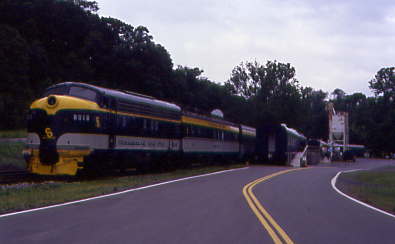
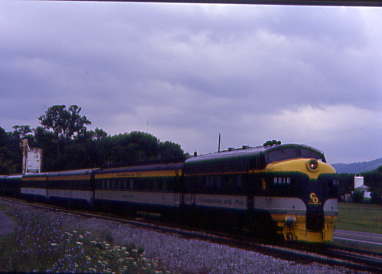
Our trainset.
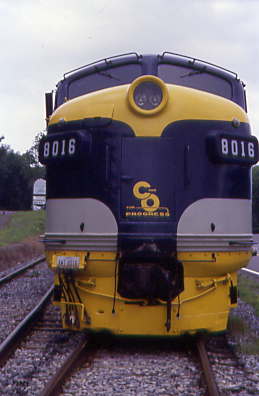
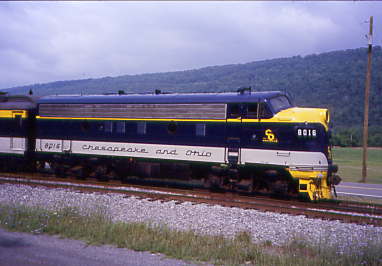
Chesapeake & Ohio FP7A 8016, ex. CSX 116 exx. Seaboard 116 nee Clinchfield F3A 800 built by Electro-Motive Division in 1948.
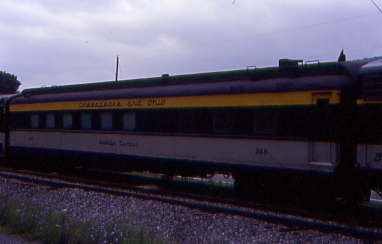
Chesapeake and Ohio first class dining car 965 "Gadsby's Tavern" built by Pullman in 1922 and used on C&O's George Washington passenger train starting in 1932 (the world’s first long-distance air-conditioned train).
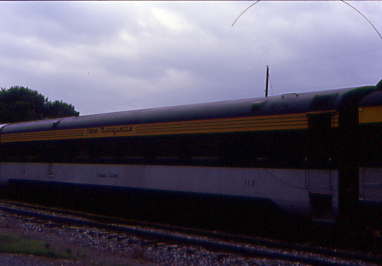
Potomac Eagle Scenic lunch counter-lounge "Eagle Canõn, ex. Amtrak 3362, exx. Penn Central 4449, exxx. Denver and Rio Grande Western 1292, nee Pere Marquette 113 built by Pullman-Standard in 1950. Both "Chessie Club" and "Eagle Canõn have since graced numerous prestigious events and notable excursions, including rides behind famous steam locomotives such as Cheasepeake & Ohio 2716 and Union Pacific 844. Today, after comprehensive restorations, these cars feature independent power plants, holding tanks and updated electrical systems, ensuring their continued operation and preservation of their historic charm. With their elegant design and storied past, these club cars offer an unmatched blend of vintage glamor and modern comfort on our railroad excursions.
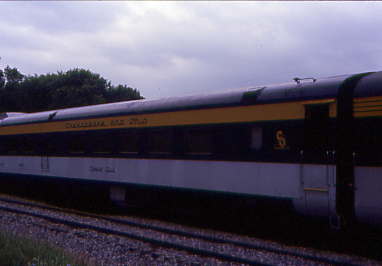
Potomac Eagle Scenic lunch-lounge car "Chessie Club", ex. Eagle Canon Passenger Car Company 3360, exx. Amtrak 3360, nee Chesapeake and Ohio 1903 "Chessie Club" built by Pullman-Standard in 1950.
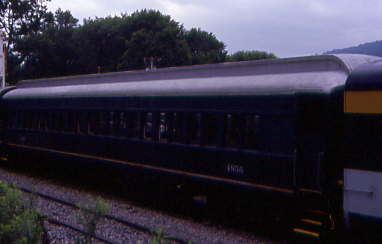
Potomac Eagle Scenic Railroad table car 4956, ex. Canadian National coach 5097, nee Canadian National 4956:2, builder and year unknown. Experience the charm of classic rail travel with our Standard Dining Service, where you can savour boxed meals inspired by vintage railway traditions. Our 1920s Standard Dining Cars offer a nostalgic dining experience with table-style seating, allowing you to enjoy your meal in a setting that echoes the elegance of a bygone era. Indulge in culinary delights that reflect the heritage of rail travel while creating new memories on your journey.
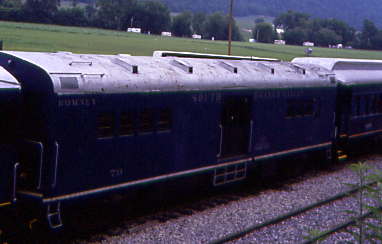
Potomac Eagle Scenic Railroad concession car 79, nee United States Army troop kitchen car 896xx built by St. Louis Car Company in 1953. As you explore the scenic beauty of our railroad journey, make sure to visit our concessions car, located centrally within the train which has been transformed into a culinary hub. It now offers a selection of treats to keep you energized throughout your trip. Indulge in classic favorites such as hot dogs, nachos, candy, chips and popcorn perfect for satisfying those mid-journey cravings. Quench your thirst with a variety of beverages, including hot coffee, soda, Gatorade and water. Designed with convenience and comfort in mind, our concessions car also features a unique snack bar tailored specifically for our coach passengers, enhancing your travel experience with a variety of refreshments.

Potomac Eagle Scenic Railroad concession car 5061, ex. Algoma Central 1992, exx. Canadian National 5061, exxx. VIA 5200, nee Canadian National 5200 built by Canadian Car and Foundry in 1937.

Potomac Eagle Scenic Railroad coach 5006, nee Canadian National 5006 built by Canadian Car and Foundry in 1937.
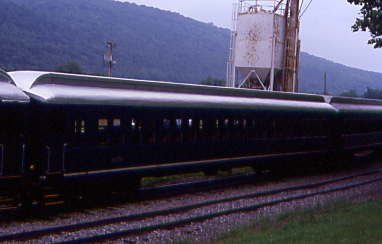
Potomac Eagle Scenic Railroad coach 4978, ex. Canadian National 4978, nee Canadian National 5119 built by Canadian Car and Foundry in 1937.
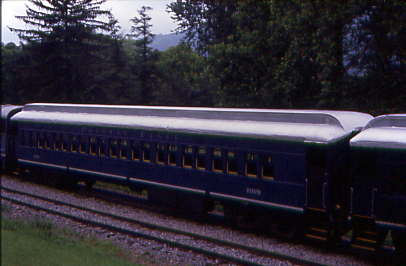
Potomac Eagle Scenic Railroad coach 4999, ex. Canadian National 4999, nee Canadian National 5113 built by Canadian Car and Foundry in 1937.
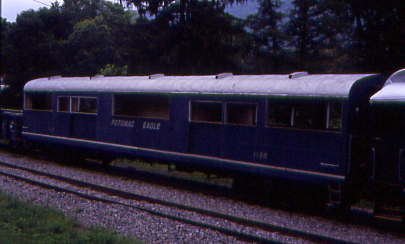
Potomac Eagle Scenic Railroad observatory car 1158, history unknown. This car features large, wide-open windows that invite you to lean out and take in the breathtaking scenery at your leisure. Enjoy the comfort of a covered roof while soaking in uninterrupted views of the canyon and its natural wonders. For added convenience, this car also includes restrooms, ensuring a comfortable and seamless journey as you marvel at the picturesque landscapes. Whether you are exploring the outdoors from the gondola or relaxing in the Observatory Car, our railroad excursion offers a unique and memorable way to experience the beauty of Trough Canyon.
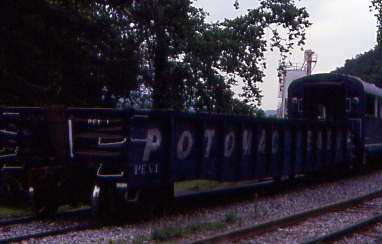
Potomac Eagle Scenic Railroad open car PESX1. Step into the thrill of adventure aboard our open-top gondola, a standout feature of our journey through Trough Canyon. Once used to transport freight, this gondola has been transformed into a comfortable space with benches for passengers to relax and enjoy a 365-degree panoramic view of the stunning canyon landscape and the majestic homes of eagles. Located at the south end of the train, the open-top gondola provides an immersive outdoor experience, allowing you to feel the rush of the wind and the exhilaration of nature's beauty all around you. It is an unforgettable way to connect with the wilderness and experience the full grandeur of Trough Canyon.
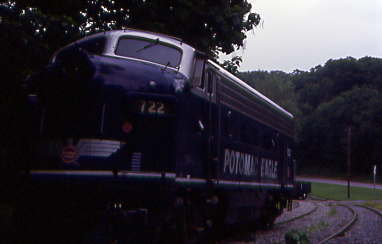
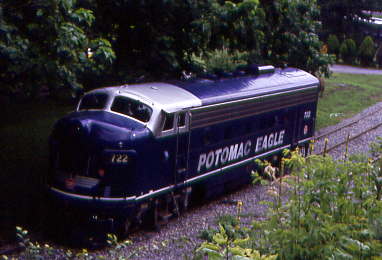
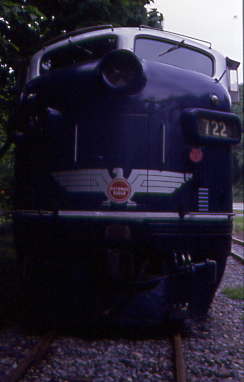
Baltimore and Ohio F7A 722, nee Bessemer and Laker Erie 722, built by Electro-Motive Division in 1952. It served for about 25 years, transporting coal, coke, and iron ore between the Great Lakes and Pittsburgh. In a bid to extend its service life, it was retrofitted for special remote control operations at B&LE's dock facility in Conneaut. Unfortunately, a freak accident in August 2000 ended its service before it could reach 50 years with the original owner.
I returned back around the train and toured the museum cars.
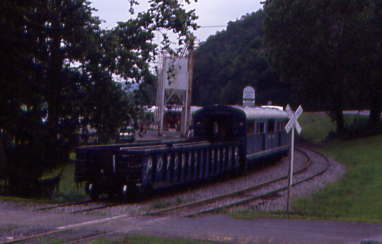
722 will reverse onto our trainset before departure so as not to block the grade crossing.

The interior of the museum car.

The Baltimore and Ohio logo, emblematic of the former ownership of this line.
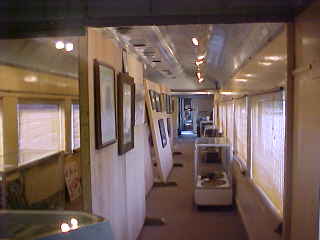
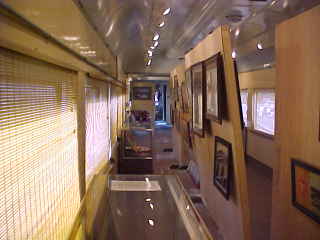
This museum car was in the throes of having displays installed. I returned outside and waited to board. The train was loaded by groups at 11:00 AM with first an Amish group from Altoona, second another group from Altoona and lastly general boarding; whereupon I settled into coach 4999.
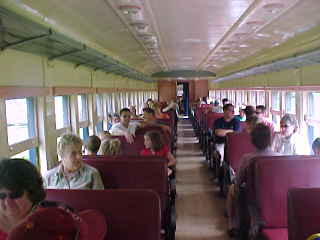
Passengers ready for our great train trip today.
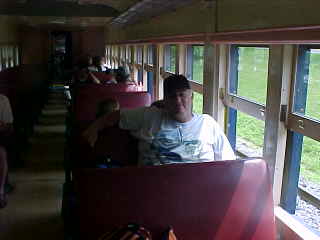
Chris Parker relaxing before we departed, which occurred at 11:35 AM by moving forward.
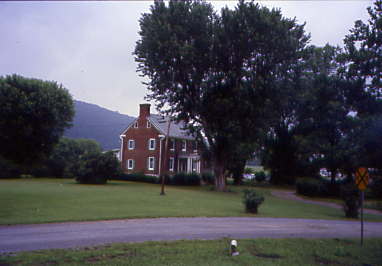
We were in the Revolutionary War area since this house was built in 1776.
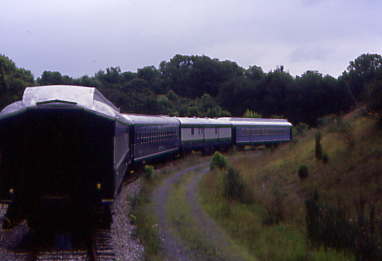
A line of passenger equipment.
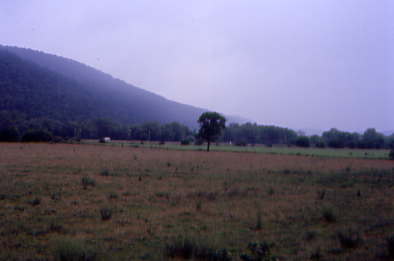
The valley looking south.
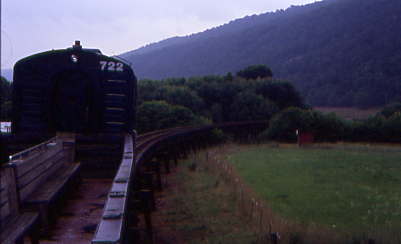
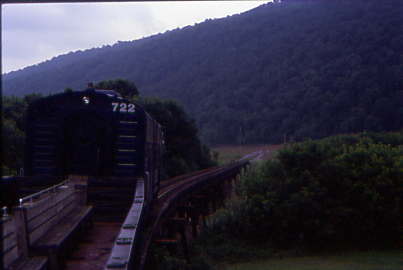
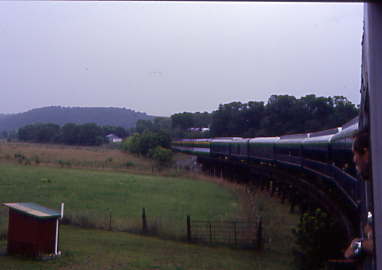


Crossing the South Branch of the Potomac River.
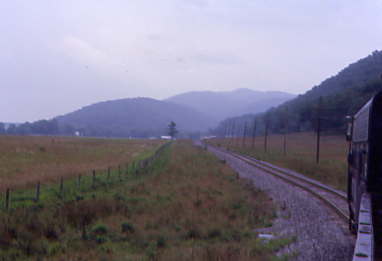
Rounding the big curve off the bridge.
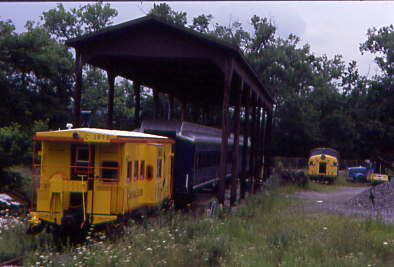
The railroad's covered car shop with an unidentified caboose and the cab of a former VIA F-unit.
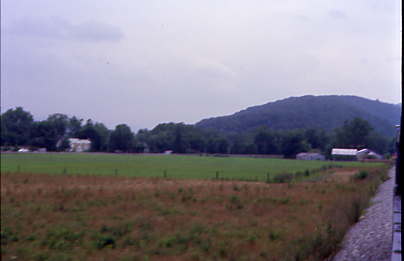
The valley.
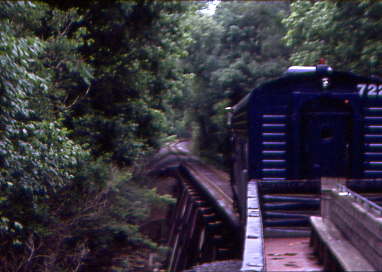
Crossing a small creek.
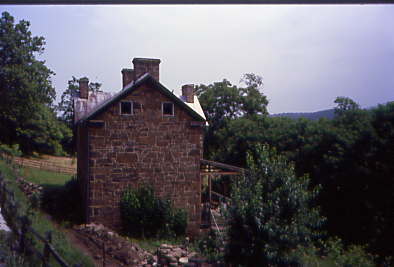
The Nathaniel and Isaac Kuykendall House, built in 1797, pre-dating the Civil War, and on the National Register of Historic Places, four miles south of Romney.
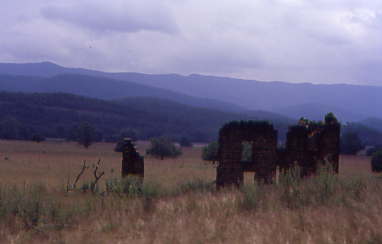
A Civil War ruin.
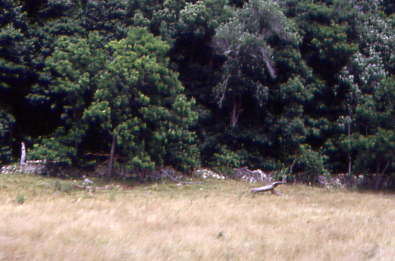
Old Plantation Wall.
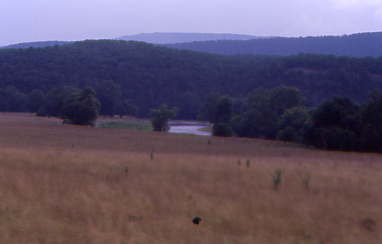
The South Branch of the Potomac River and the valley.
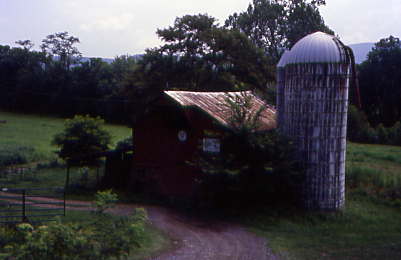
A barn and grain silo. I spotted a group of geese standing on the rocks in the river.
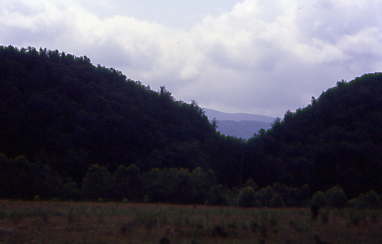
Near Sector, a gap on the south side of the valley.
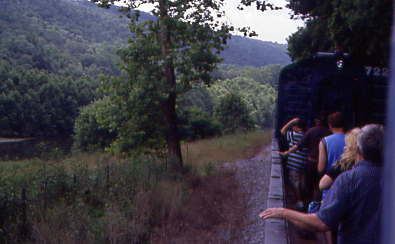
Here the train stopped and the open car was made available for all passengers until it filled up. Anyone who did not get into the open car going south could ride it northbound. The car is opened here because the train passes through the beautiful Trough where all the bald eagles are found and since there are no roads into the Trough, it is just the train, the river and the bald eagles. I could not wait to enjoy this experience.

A full open car as we were ready to proceed south into the Trough, where the South Branch of the Potomac River cuts through the mountains. It is one of West Virginia's very own "Grand Little Canyons". George Washington referred to the canyon as "The Trough" during his 1748 surveying expedition as he gazed into the canyon and declared it was impassable beyond. In 1756, a band of Shawnee defeated European settlers in a bloody skirmish known as the Battle of the Trough during the French and Indian War. This six-mile long canyon has steep, forested walls and is part of the Appalachian Forest National Heritage Area. Hardwood species, primarily of oak and hickory, blend with evergreens to create an abundant forest biodiversity. Spectacular cliffs and rock outcrops along ridgelines create the unique canyon ecosystem. Passengers commonly view songbirds, waterfowl, raptors, turkey vultures, deer, black bears, wild turkeys and turtles.
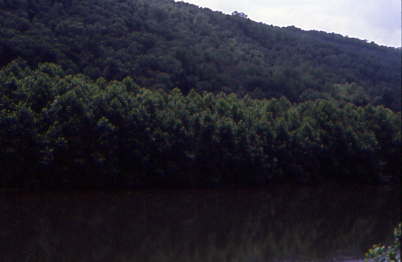
A deer ran in front of the train then up the hill away from the river.
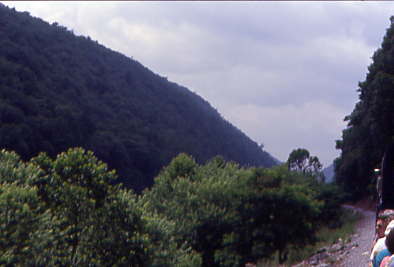
Passengers were on bald eagle watch as we entered the Trough.
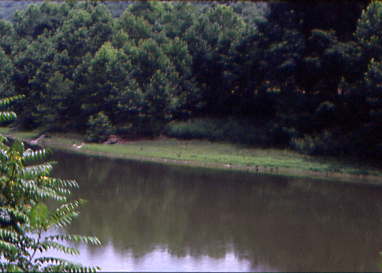
Geese on the bank of the river.
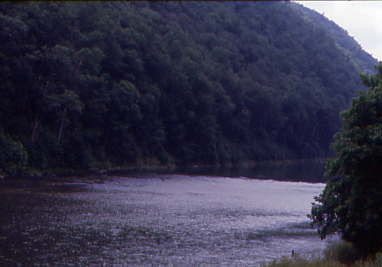
The Potomac River. A young bald eagle flying downriver was spotted, which started the passengers looking for and calling out whenever a bald eagle was sighted.
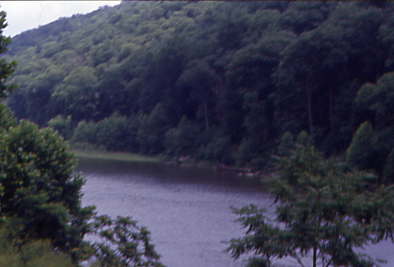
A mature bald eagle was spotted.
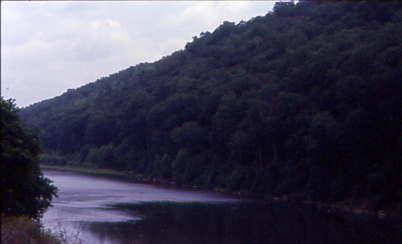
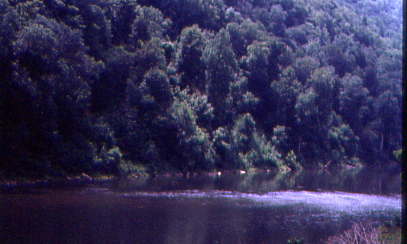
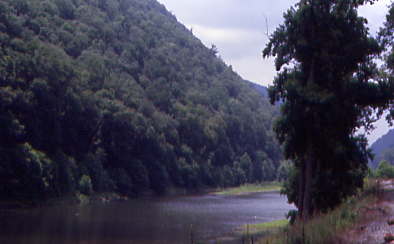
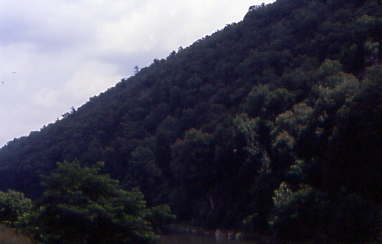
The Trough.
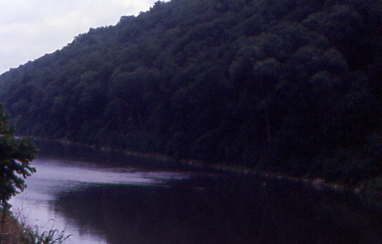
Bald eagles flying downstream.
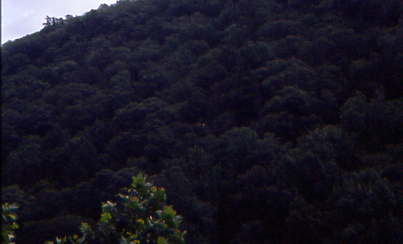
A bald eagle in its nest.
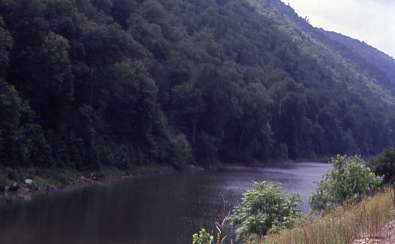
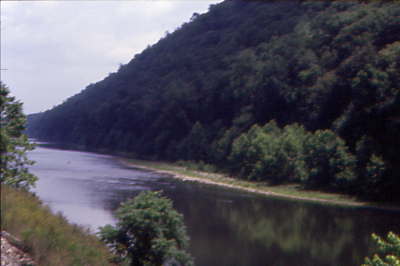
The Trough.
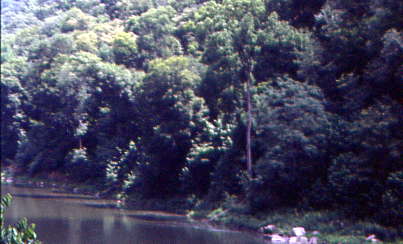
A bald eagle in a tree.
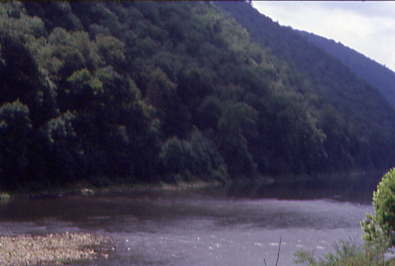
The Trough is a peaceful and beautiful place.
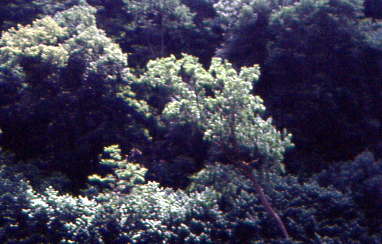
We next saw a bald eagle's nest.
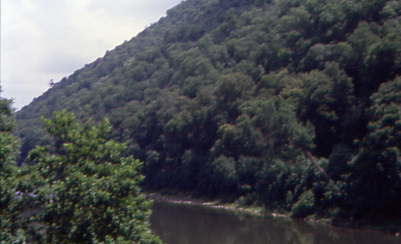

Continuing to parallel the river.

A look back.
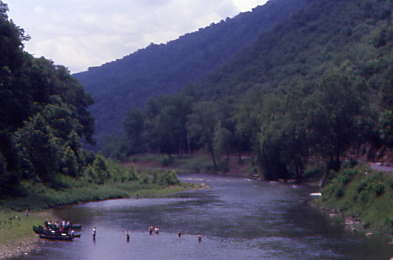
The view to the rear with rafters on the Potomac River.
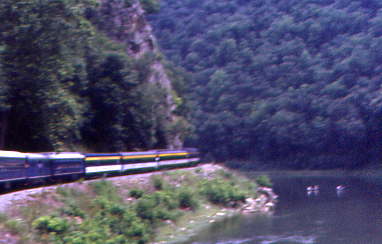
We ran below Eagle Rock.
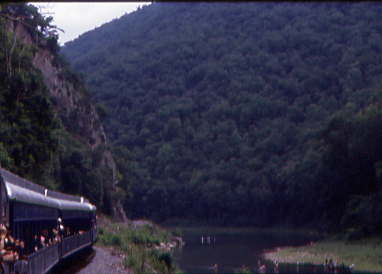
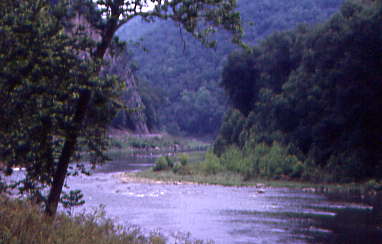
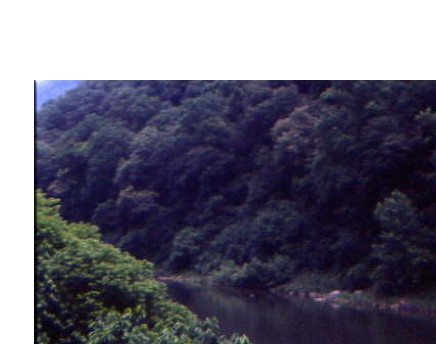
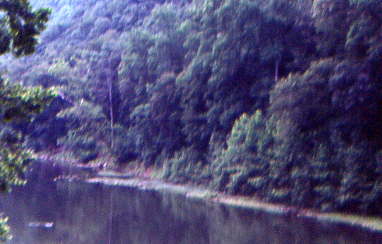
The Trough continue to amaze us.
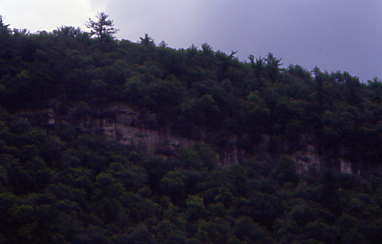
Rock layers near the top of the Trough.
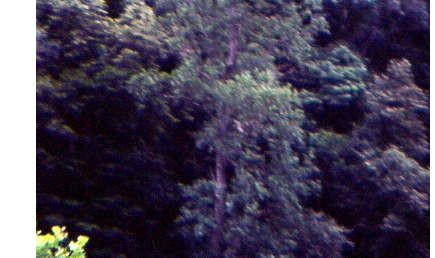
A bald eagle in the tree.
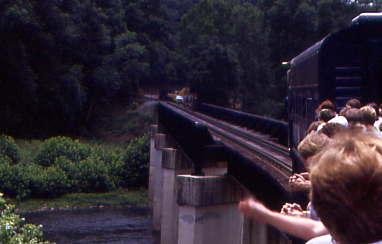
Crossing the South Branch of the Potomac River.
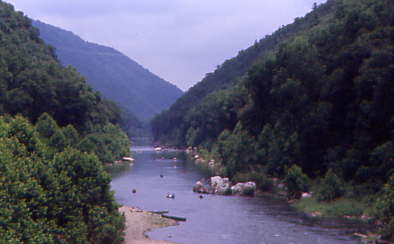
A look back into the Trough.
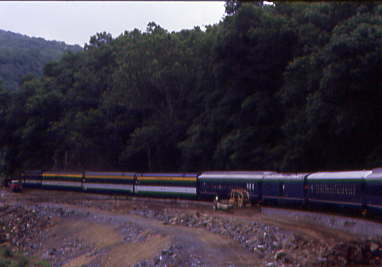
Our train passed a construction zone. We stopped and all passengers were required to leave the open car before we continued to Moorefield, West Virginia, our turn-around point on this trip.
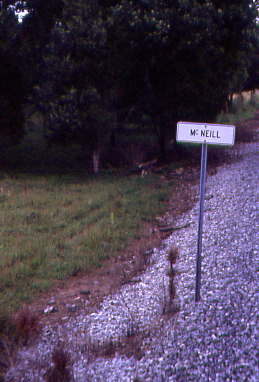
We then passed through McNeill, West Virginia.
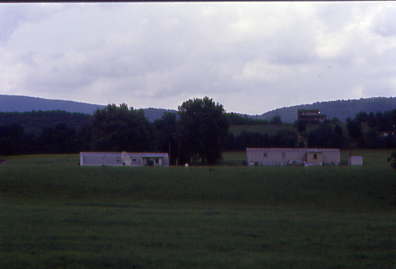
A house on the hill.
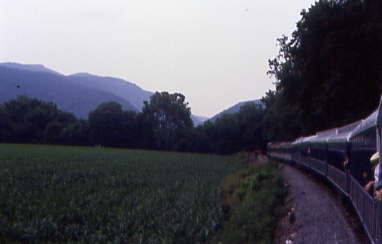
Passing a cornfield.
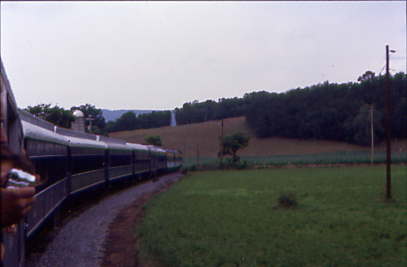
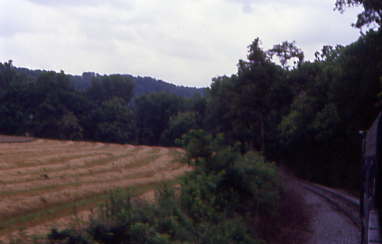
Fields.
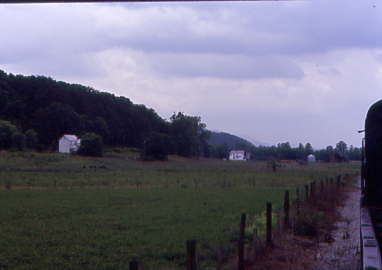
A nice rural view.
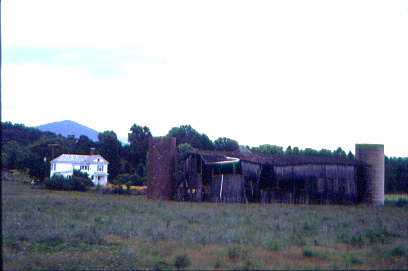
A house and its barn.
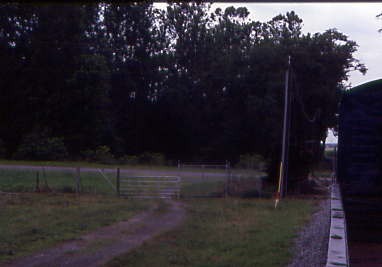
We arrived at Moorefield at 1:30 PM and our crew switched ends and we started the journey back to Romney, during which I relaxed and enjoyed the scenery with just a few more pictures.
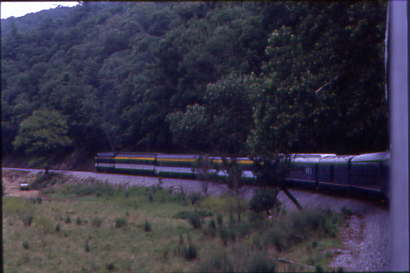
Approaching the construction zone with Chesapeake and Ohio 8016 now leading us.
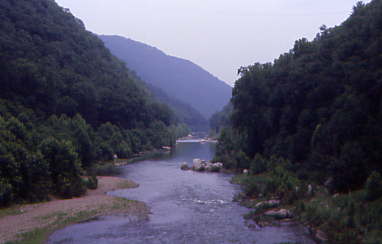
Looking north down into the Trough.
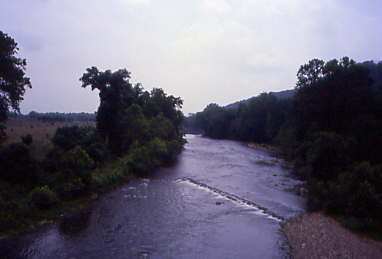
Looking up the South Branch of the Potomac River.
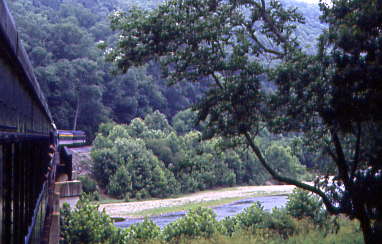
Crossing the bridge across the Potomac River.
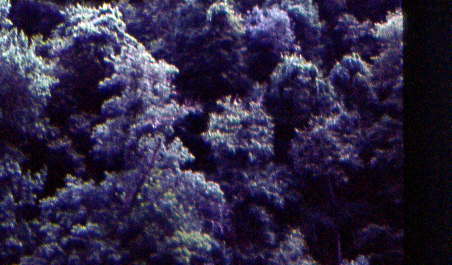
The bald eagle was still sitting in his tree.
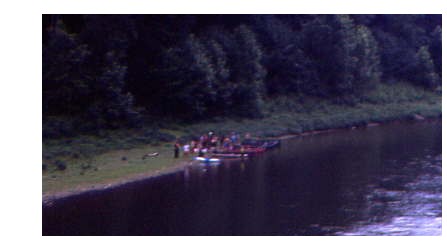
Rafters resting on a hot and very humid day. I bet the water felt good!
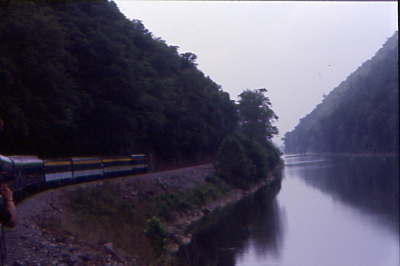
Our train along the South Branch of the Potomac River. After that, I was given a tour of the First Class cars, in which one rides if you pay for a First Class ticket.
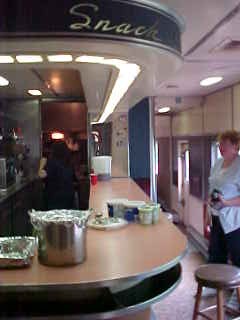

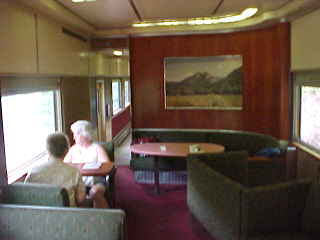
Interior of 1903 "Chessie Club".
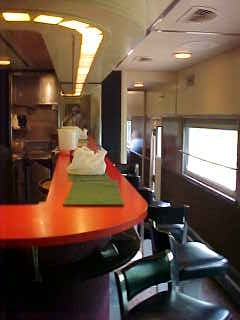

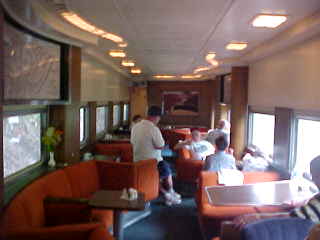
Interior of 113 "Eagle Canõn".
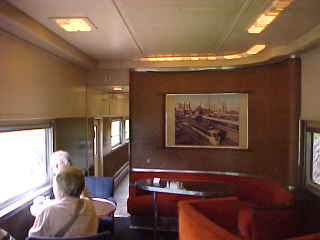
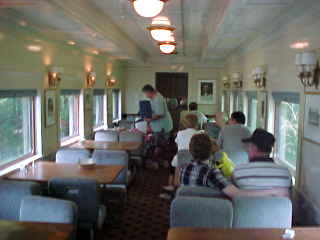
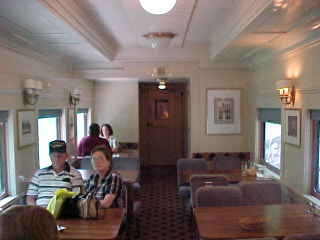
Interior of 965 "Gadsby's Tavern".
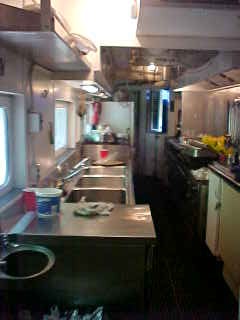
The kitchen of "Gadsby's Tavern". I was then led into Chesapeake and Ohio 8016 for a cab ride for the rest of the way back to Romney. Now sit back and enjoy this with me.
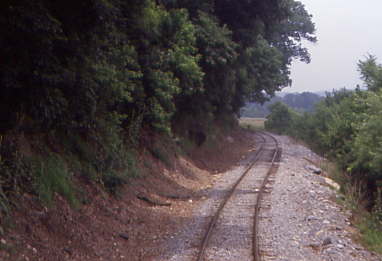
The view was great!

Approaching a siding.
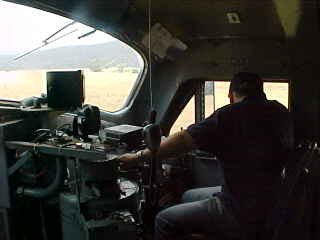
Our engineer looking back to see if the rear of our train has passed the end of a slow order.
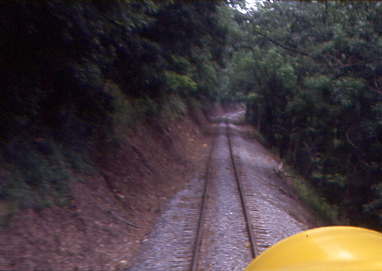
Seeing a deer run in front of a train was really something.
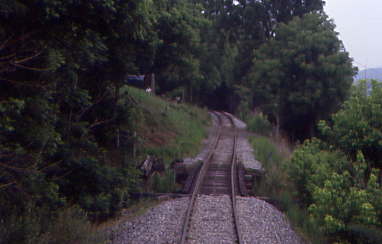
Crossing a little creek.
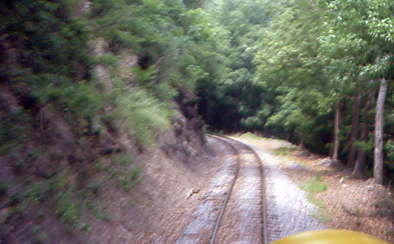
Coming into a curve, you always wonder what might be coming into view?

A cab ride was what sparked the concept for the dome car.
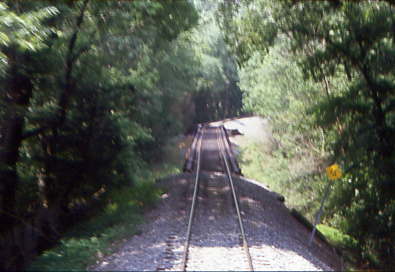
Every cab ride I take is a thrill!
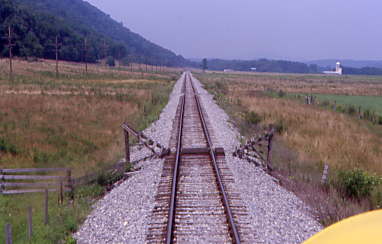
Approaching Romney.
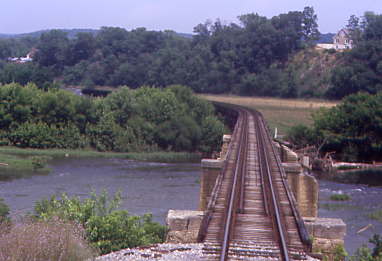
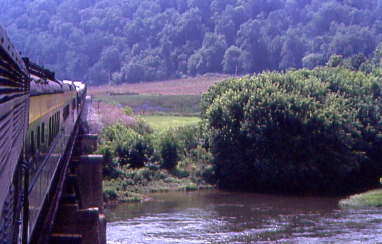
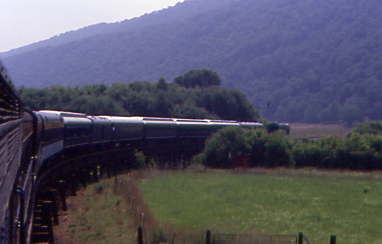
As we neared Romney, I thanked the engineer for this unique opportunity then went back through the train to pack and be ready to detrain when we arrived, which occurred at 3:13 PM, ending a fantastic trip on the Potomac Eagle Scenic Railroad. I recommend this trip to anyone who wants a great train ride, see fantastic scenery and enjoy the bald eagles in the Trough.
| RETURN TO THE MAIN PAGE |